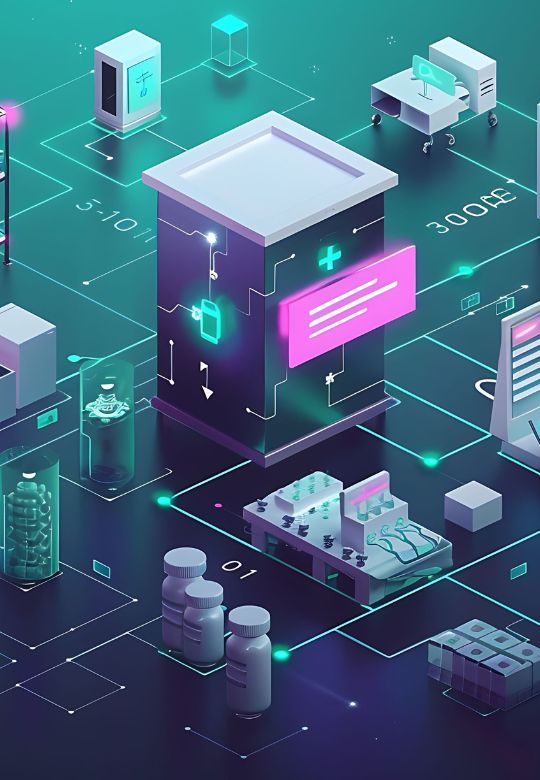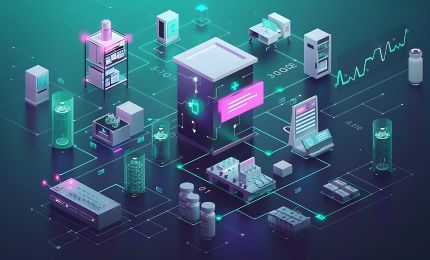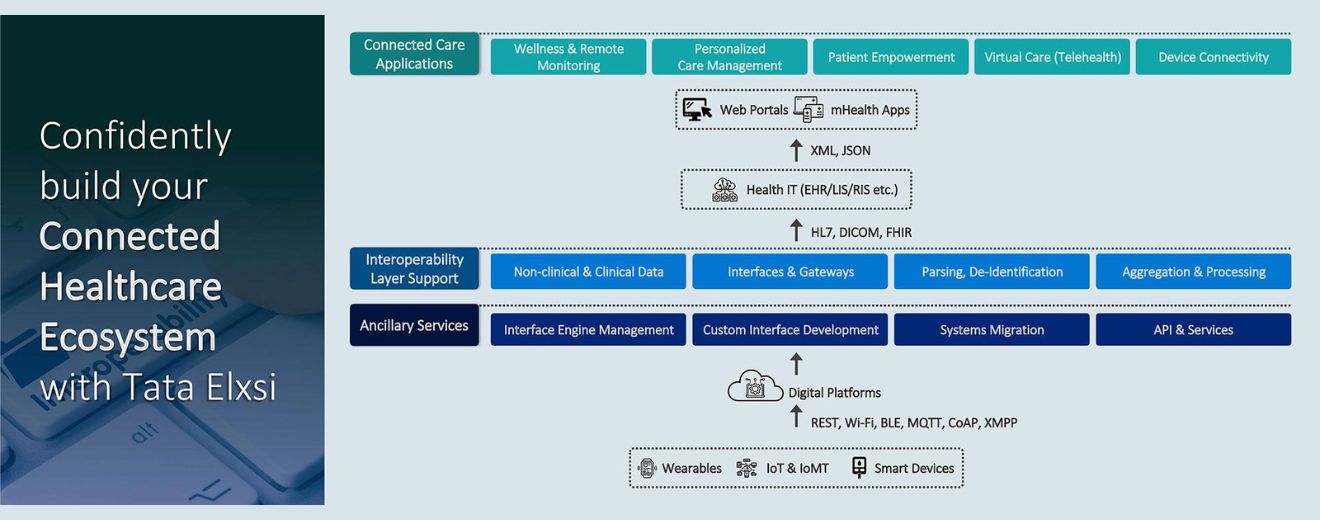

Seamless Healthcare Interoperability
Break data silos and enable connected care with Tata Elxsi’s FHIR-based interoperability solutions for healthcare systems and devices.
Understanding Interoperability in Healthcare
As healthcare systems evolve towards digitization, Healthcare Interoperability underpins the seamless exchange of patient information. By integrating data from diverse IoT-enabled medical devices, cloud platforms, and healthcare IT systems, providers can securely gather, analyze, and share insights. This synergy accelerates digital health initiatives, supports clinical decision-making, and enhances patient outcomes and operational efficiency across the care continuum.
With standards like HL7, FHIR, and DICOM driving data interoperability, healthcare businesses can reduce manual errors, improve workflows, and unlock new avenues for innovation. These interoperable solutions foster a future-ready ecosystem where devices, applications, and systems collaborate to deliver high-quality patient care.
FHIR-Compliant Centralized Information System for Remote Monitoring
Interoperability Opportunities for Healthcare Businesses
By adopting and implementing healthcare interoperability, medical device manufacturers are demonstrating their commitment to providing high-quality, efficient treatment, thereby enhancing their brand image. Making medical equipment compatible with a wide variety of healthcare systems and devices broadens the market reach and opens up new avenues for manufacturers. However, there are several challenges to achieving interoperability in healthcare, including technical barriers, regulatory issues, and a lack of standardization. The industry shift to HL7-, FHIR-, IHE-, or DICOM-driven interoperability is improving the coordination and effectiveness of care, resulting in better health outcomes for patients, and lowering healthcare costs associated with time-consuming and error-prone manual work. Moreover, medical device data management and analysis can assist manufacturers in gaining insights into how their products are being used, thereby facilitating the improvement of products' design and function.


Here’s How We Help
Integration and Standardization
- Develop APIs and interfaces ensuring HL7, IHE, and DICOM compliance for streamlined data exchange across platforms.
- Leverage ingestion frameworks to unify structured, semi-structured, and unstructured clinical data, reducing manual errors.
Implementation and Support
- Provision on-premise or cloud environments, configure interfaces, and handle integration testing for end-to-end readiness.
- Deliver customized training modules and user manuals to enhance adoption, reduce downtime, and strengthen governance.
Advanced Analytics and Security
- Enable real-time data monitoring and AI-driven insights to optimize device performance and support proactive decision-making.
- Implement robust cybersecurity measures and compliance checks, safeguarding sensitive patient and organizational data.
- Refine legacy systems with code refactoring and database migration to ensure scalability and consistent performance.
Healthcare Interoperability Implementation Framework

Our comprehensive healthcare interoperability solutions framework integrates devices, EHR systems, and cloud-based services using standards like HL7, FHIR, and DICOM. It orchestrates data ingestion, normalization, analysis, and secure exchange layers. This holistic approach empowers healthcare providers to gain actionable insights, streamline clinical workflows, and ensure a robust, compliant, and future-ready care ecosystem. It enhances care coordination and fosters further innovation.
Applications & Data Flow
At the top, the framework supports a wide range of connected care applications including wellness and remote monitoring, personalized care management, patient empowerment, virtual care (telehealth), and device connectivity. Data flows through web portals and mHealth apps, using formats like XML and JSON, and connects to health IT systems such as EHR, LIS, and RIS through healthcare standards like HL7, DICOM, and FHIR.
Interoperability Layer
The core of the framework lies in its interoperability layer support, which manages both non-clinical & clinical data. Key capabilities include interfaces & gateways, parsing and de-identification, and aggregation and processing. These services enable structured, secure, and standardized data exchange between systems, ensuring that diverse sources can contribute to a unified, accessible, and compliant data ecosystem.
Ancillary Services & Platform Integration
Supporting this architecture are ancillary services such as interface engine management, custom interface development, systems migration, and API & services for integration. These services are powered by digital platforms that use protocols like REST, MQTT, BLE, and XMPP. The solution seamlessly connects with edge devices ensuring interoperability from device to enterprise level for scalable, future-ready healthcare systems.
Why Tata Elxsi?
- Dedicated healthcare interoperability expertise ensuring robust industry standards compliance, rapid integration, and significantly reduced time-to-market.
- Ready-to-deploy accelerators that minimize development costs, streamline implementation, and consistently deliver measurable operational benefits quickly.
- Global delivery model providing scalable resources, localized support, and collaboration across geographies and time zones.
- Proven implementation methodologies ensuring thorough risk assessment, seamless integration, and reliable performance in critical deployments.
- End-to-end cybersecurity solutions safeguarding patient data, meeting compliance mandates, and enabling secure, future-ready healthcare operations.
Information Hub
-
What is healthcare interoperability, and why is it important?
Healthcare interoperability refers to the ability of medical devices, EHR platforms, and health IT systems to seamlessly exchange, interpret, and use data. It ensures that patient information is available at the right time, improving clinical decision-making, minimizing errors, and optimizing outcomes. Interoperability also fosters collaboration among multiple stakeholders, supporting integrated care models and reducing administrative burdens. Ultimately, it enables more effective digital health initiatives, paves the way for continuous innovation, and enhances overall patient safety, satisfaction, and healthcare quality.
-
How do HL7, FHIR, and DICOM standards support interoperability?
These standards define protocols and data formats that allow different healthcare systems to communicate effectively. HL7 focuses on structured data exchange, while FHIR streamlines information sharing through web-based resources and APIs. DICOM standardizes the management of medical imaging data. By adopting these frameworks, organizations ensure consistent data interpretation, reduce integration complexities, and improve compliance. Collectively, they enable more seamless health IT interoperability, promoting better collaboration among stakeholders, enhancing patient outcomes, and facilitating faster innovation across the connected ecosystem.
-
Can interoperability solutions integrate legacy medical devices and health IT systems?
Yes. Modern healthcare interoperability solutions are designed to bridge diverse technologies, including older devices and outdated software. Through specialized APIs, connectors, or middleware, data can be translated into standardized formats like HL7 or FHIR. This enables legacy systems to communicate effectively with newer applications and cloud-based platforms. While additional effort may be required to address compatibility or security gaps, integrating older infrastructures helps preserve existing investments, facilitates comprehensive data access, and ultimately enhances care quality across the organization.
-
What are the benefits of working with a specialized partner like Tata Elxsi?
A specialized partner offers deep domain expertise, proven methodologies, and end-to-end capabilities spanning standards compliance, software development, cybersecurity, and beyond. By leveraging ready-to-deploy accelerators, industry best practices, and dedicated interoperability teams, organizations can reduce time-to-market, minimize risks, and ensure optimal resource utilization. Tata Elxsi’s global delivery model further enables localized support, scalable workforce solutions, and agile collaboration. This holistic approach translates into successful implementations, strengthened brand reputation, and sustainable growth in an ever-evolving healthcare landscape.
-
How long does it typically take to implement a healthcare interoperability project?
Implementation timelines vary based on project scope, existing infrastructure, and stakeholder readiness. Smaller integrations, such as connecting a few EHR modules, may be completed in a few weeks, while complex, enterprise-wide health IT transformations can span several months or more. Factors like regulatory compliance, data migration, and customization requirements also influence project duration. Partnering with an experienced provider, armed with accelerators and proven frameworks, can significantly reduce time-to-market, ensuring a smoother transition and quicker realization of patient care benefits.











